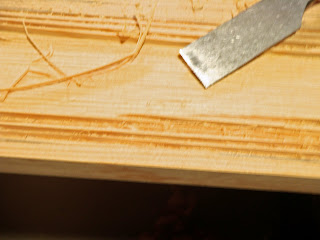


OK, I told you all about the sweet piece of VG fir I got to machine into various structural members for the Summerbreeze I'm currently building. Here's how I got out the rub rails from that board.
The plans call for a 1/2" to 5/8" thick by 1.5" wide strip to be utilized for the gunwale, or rubrail, or guard,if you prefer. This is the batten that's installed on the outside of the planking at the sheer. I was fine with that, but concerned about the exposed end grain at the top of the plank. I could just install this rail, then install a similiar rail inside as an inwale and then cap the top with a covering board. BUT....I want open gunwales, with spacers, both for the aesthetics, and for the functionality of being able to turn the boat over after a sail and having all the water run out. So here's what I came up with.
I measured and marked the width of both rubrails on the edge of my board, adding, and marking for, 3/8" wide rabbet( short L-shape) to be cut out. When installed, the rabbet will cover the exposed grain of the ply at the top of the sheer. I tacked my trusty aluminum channel as a fence, set my saws depth of cut to 6mm (1/4"), the planking thickness. I then made two very accuarate cuts with the aluminum guide, each side of my marked width. I then used the saw free-hand to make about 20-kerfs(cuts) between the accurate cuts. I then chiseled out the waste. Voila! Rabbbeted rubrails! All I have to do now is remove the rest of the waste, then mark an cut down the center and I'll have two rails with protective sheer rabbets. ( Hey, did I just invent a new term?)
This technique is very easy when you're chisleling across the grain. Here, I had to do it along the grain, which is very splintery work. You go easy, pushing the chisel slow and steady. I also wore leather gloves which saved my from getting porcupined about a hundred times.




No comments:
Post a Comment